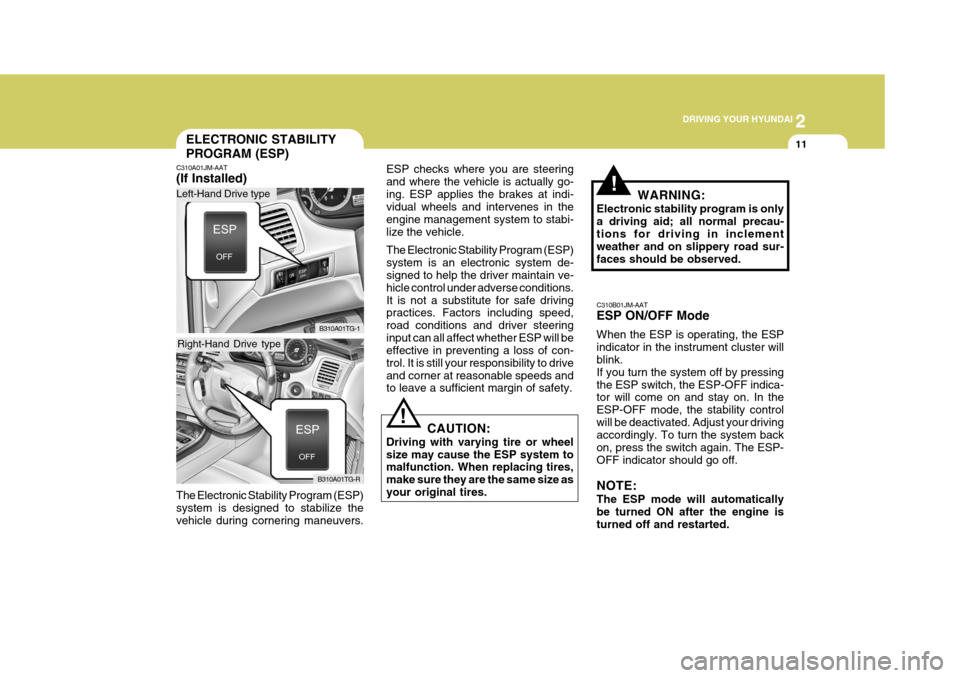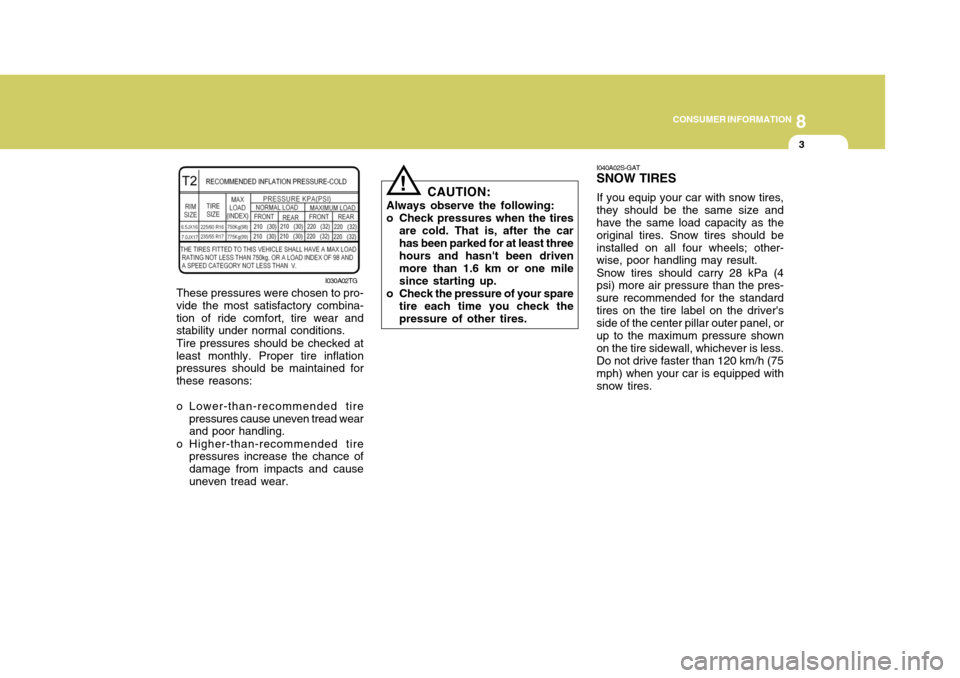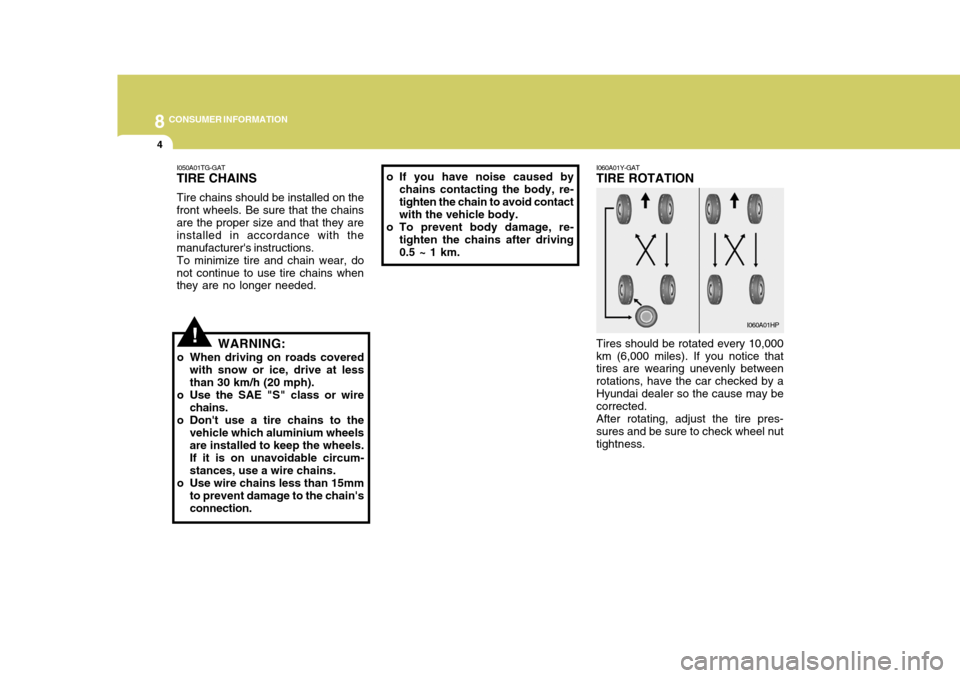Page 195 of 297

2
DRIVING YOUR HYUNDAI
11
!
CAUTION:
Driving with varying tire or wheel size may cause the ESP system to malfunction. When replacing tires, make sure they are the same size asyour original tires. WARNING:
Electronic stability program is onlya driving aid; all normal precau- tions for driving in inclement weather and on slippery road sur-faces should be observed.!
ELECTRONIC STABILITY PROGRAM (ESP)
C310A01JM-AAT (If Installed) ESP checks where you are steering and where the vehicle is actually go-ing. ESP applies the brakes at indi- vidual wheels and intervenes in the engine management system to stabi-lize the vehicle. The Electronic Stability Program (ESP) system is an electronic system de- signed to help the driver maintain ve- hicle control under adverse conditions.It is not a substitute for safe driving practices. Factors including speed, road conditions and driver steeringinput can all affect whether ESP will be effective in preventing a loss of con- trol. It is still your responsibility to driveand corner at reasonable speeds and to leave a sufficient margin of safety.
B310A01TG-1
C310B01JM-AAT ESP ON/OFF Mode When the ESP is operating, the ESP indicator in the instrument cluster will blink. If you turn the system off by pressingthe ESP switch, the ESP-OFF indica- tor will come on and stay on. In the ESP-OFF mode, the stability controlwill be deactivated. Adjust your driving accordingly. To turn the system back on, press the switch again. The ESP-OFF indicator should go off. NOTE: The ESP mode will automatically be turned ON after the engine is turned off and restarted.
The Electronic Stability Program (ESP) system is designed to stabilize thevehicle during cornering maneuvers.
B310A01TG-R
Left-Hand Drive type
Right-Hand Drive type
Page 284 of 297

8
CONSUMER INFORMATION
3
CAUTION:
Always observe the following:
o Check pressures when the tires are cold. That is, after the carhas been parked for at least three hours and hasn't been driven more than 1.6 km or one milesince starting up.
o Check the pressure of your spare tire each time you check thepressure of other tires.
These pressures were chosen to pro-vide the most satisfactory combina-tion of ride comfort, tire wear and stability under normal conditions. Tire pressures should be checked at least monthly. Proper tire inflation pressures should be maintained for these reasons:
o Lower-than-recommended tire
pressures cause uneven tread wear and poor handling.
o Higher-than-recommended tire pressures increase the chance of damage from impacts and causeuneven tread wear.
! I040A02S-GAT SNOW TIRES If you equip your car with snow tires, they should be the same size and have the same load capacity as the original tires. Snow tires should beinstalled on all four wheels; other- wise, poor handling may result. Snow tires should carry 28 kPa (4 psi) more air pressure than the pres- sure recommended for the standardtires on the tire label on the driver's side of the center pillar outer panel, or up to the maximum pressure shownon the tire sidewall, whichever is less.Do not drive faster than 120 km/h (75mph) when your car is equipped withsnow tires.
I030A02TG
Page 285 of 297

8CONSUMER INFORMATION
4
!
I060A01Y-GAT TIRE ROTATION Tires should be rotated every 10,000 km (6,000 miles). If you notice that tires are wearing unevenly between rotations, have the car checked by aHyundai dealer so the cause may be corrected. After rotating, adjust the tire pres- sures and be sure to check wheel nut tightness.
I050A01TG-GAT
TIRE CHAINS
Tire chains should be installed on the
front wheels. Be sure that the chains are the proper size and that they are installed in accordance with themanufacturer's instructions. To minimize tire and chain wear, do
not continue to use tire chains when they are no longer needed.
WARNING:
o When driving on roads covered with snow or ice, drive at less than 30 km/h (20 mph).
o Use the SAE "S" class or wire
chains.
o Don't use a tire chains to the
vehicle which aluminium wheelsare installed to keep the wheels. If it is on unavoidable circum- stances, use a wire chains.
o Use wire chains less than 15mm to prevent damage to the chain'sconnection. o If you have noise caused by
chains contacting the body, re-tighten the chain to avoid contact with the vehicle body.
o To prevent body damage, re- tighten the chains after driving 0.5 ~ 1 km.
I060A01HP
Page 286 of 297

8
CONSUMER INFORMATION
5
!WARNING:
Do not mix bias-ply and radial-ply
tires under any circumstances. This may cause dangerous handling characteristics that may cause death, serious injury, or propertydamage. I070A01A-AAT TIRE BALANCING A tire that is out of balance may affect handling and tire wear. The tires on your Hyundai were balanced before the car was delivered but may needbalancing again during the years you own the car. Whenever a tire is dismounted for repair, it should be rebalanced before being reinstalled on the car. I080A01A-AAT TIRE TRACTION Tire traction can be reduced if you drive on worn tires, tires that are improperly inflated or on slippery road surfaces. Tires should be replacedwhen tread wear indicators appear. To reduce the possibility of losing control, slow down whenever there israin, snow or ice on the road.
I090A01Y-GAT WHEN TO REPLACE TIRES The original tires on your car have tread wear indicators. The tread wear indicators appear when the treaddepth is 1.6 mm (0.06 in.). The tire should be replaced when these ap- pear as a solid bar across two ormore grooves of the tread. Always replace your tires with those of the recommended size. If you changewheels, the new wheel's rim width and offset must meet Hyundai speci- fications.HTG5016
Tread wear indicator
1.6 mm (0.06 in.)
Page 287 of 297
8CONSUMER INFORMATION
6
!
SPARE TIRE AND TOOLS
I100A01NF-GAT Your Hyundai is delivered with the following: Spare tire and wheel Wrench bar (1), Jack (2), Wheel nut wrench (3), Spanner (4), Tool Receptacle (5), Screwdriver (6)
WARNING:
o Driving on worn-out tires is dan- gerous! Worn-out tires can cause loss of braking effective-ness, steering control and trac- tion. When replacing tires, never mix radial and bias-ply tires onthe same car. If you replace ra- dial tires with bias-ply tires, they must be installed in sets of four.
o Using tires and wheels of other than the recommended sizesmay cause unusual handling characteristics that may cause death, serious injury, or prop-erty damage. I100A01TG
Page 289 of 297
9 VEHICLE SPECIFICATIONS
2
Standard OptionSpare
225/60 R16
235/55 R17
Full Size
3.3L
130A (13.5V)
J010A01TG-GAT MEASUREMENT4895 (192.7)
1865 (73.4) 1490 (58.6)
2780 (109.4)
1580 (62.2)1565 (61.6)
Overall lengthOverall width Overall heightWheel base Wheel tread
Front
Rear
Type Wheel free play Rack strokeOil pump type Rack and pinion0 ~ 30 mm (0 ~ 1.18 in.) 146 mm (5.74 in.) Vane type
J060A01TG-GAT FUEL SYSTEM
J020A01TG-GAT POWER STEERING J030A01TG-GAT TIRE
Item BatteryAlternator
J040A01TG-GAT ELECTRICAL
mm (in.)
Fuel tank capacity75 liter
CMF 68AH
J050A01TG-GAT BRAKE
Dual hydraulic with brake booster Ventilated discSolid disc Cable operated on rear wheel
Type Front brake typeRear brake type Parking brake